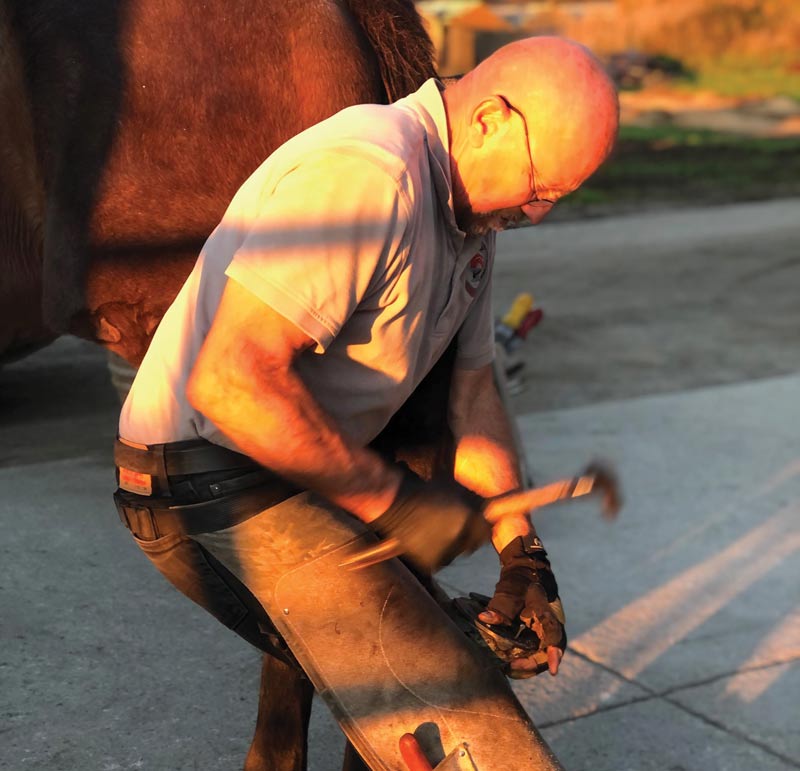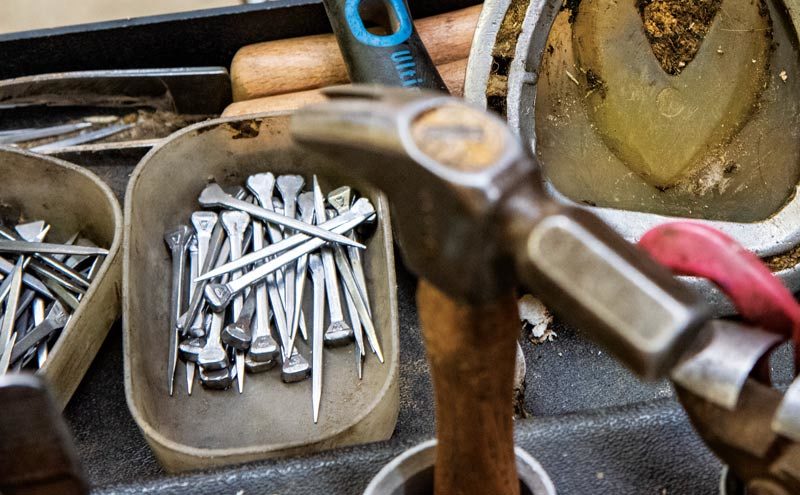Sometimes the smallest change makes the biggest difference in your own business. That’s what Steve Wiberg, a Hayward, Calif.,-based farrier discovered when he made the switch from leather impact horseshoe pads to plastic pads.
“I can buy plastic pads for $1.89 less a pair than the regular leather pads, and for $4.30 less than heavy leather pads. I average about five pairs of pads a day, which comes to around 1,560 pairs of pads each year,” says Wiberg. “By using the plastic pads instead of the regular leather ones, I can save more than $2,900 every year. If I switched away from heavy leather pads, that’s a savings of about $6,850. That’s a lot of money, and that’s just on pads.”
Wiberg notes that while leather pads are still effective under the right circumstances, it was a personal preference to start using mainly plastic pads in his practice. He says it’s all about inventory management, no matter what products you use.
This is where those small adjustments begin to stack up. Wiberg states that his savings go deeper than just the pads.
“I find these thinner pads are less likely to break your drill bits as you are trying to fit them to the shoe and hoof,” says Wiberg. “I don’t have to buy extra drill bits, which is small, but another savings.”
The second concept Wiberg illustrates is that since plastic pads are easier to manipulate, he does not have to spend as much time or money drilling or buying drill bits. By cutting out the drilling process of making the pads viable for use in shoeing, he also cuts down on labor costs.
“That’s more time shoeing or otherwise managing your business,” he says.
While Wiberg admits he wasn’t going through many bits before, if he can save a few bits or make them last a little longer, those little savings add up.
“So many people, farriers or otherwise, have the attitude of ‘you go get it, it works, run with it,’” Wiberg notes. However, analyzing your business expenses and return on investment can bring forth some positive impact on your business.
Wiberg says that these changes do not have to come about due to micromanaging, but by taking a deep dive into your expenses and thinking through your processes step-by-step, you can make serious changes that will better your bottom line.
The veteran farrier also says that it is important not to let your previous inventory, like the leftover leather pads, go to waste.
“Once you decide to make those changes, you can still use the products you have. It’s the farrier’s and owner’s discretion on which products you use as you make the switch,” he says. “Let them know about the change in advance, as that will build your trust with the client.”
Beginning an Evaluation
Wiberg advises farriers to begin an exercise of looking at inventory to compare price differences and changes. If it seems like a daunting task, start with a single high inventory product.
“I discovered these savings accidentally,” he says. “You have to be open-minded about what is available. If you want to be contentious, you have to take the time to break down these costs. Go through your truck. You need to understand what products are available.”
Look after your pennies in order for them to make dollars …
Growing your product knowledge is the key. Learn about products from other farriers, trade shows or American Farriers Journal, he says. Your relationship with your supply shop is instrumental because they can explain product alternatives or educate you on what other farriers have found useful in their practices.
He warns just because something is less money, look at the long-term impact of the product’s reliability and effectiveness before switching it into your inventory. There may be more to gain from using a more expensive product dependent on the variables of your practice.
What’s Your Profit Margin?
Wiberg also notes that all farriers should be looking for ways to increase their profit margin while running their business. As an example, Wiberg is selective in his choice of shoes.
“They are a dollar cheaper than most any other pair of shoes,” he says. “I can save countless dollars each year by spending $1 less, while still not sacrificing quality of product or service.”
Wiberg says expense reduction and its affect on your profit margin grows as you look for other ways to reduce spending. For example, he advises farriers to keep in tune with which fuel stations have the cheapest gas. Price comparison apps can affect this, too.
“You will notice this as you drive around, so keep mental notes in the least,” he says. “The station closest to my house is 30 cents more expensive than one that is on my route. So, I place when I can refuel on my route and save on diesel.”
Wiberg tries to shoe in clusters of clients. He doesn’t rely on a set driving range for each day or client. Rather, he has a revolving door of a shoeing schedule. If someone calls and says they need a trim, he makes it happen in a day or 2. He reasons that it won’t hurt the horse to go 6 weeks and 3 days.
“I don’t get hung up on the shoeing schedules,” he says. “If I can shoe 10-15 horses in a couple of stops, what am I going to save? Not only am I going to save time, but I will save on gas, on mileage, wear and tear on my truck, and my hourly rate is better because I am just making a stop or two.”
Wiberg credits another opportunity with his ability to save on expenses and increase his profit margin; the fact that the Sacramento, Calif.-based Horseshoe Barn will deliver supplies to Wiberg monthly.
Wiberg points out that not only are these savings directed to the farriers receiving deliveries, but also to the suppliers themselves. When the supplier delivers crates of shoes, nails, pads and other equipment to Wiberg, they no longer have to stock it themselves. That reduces labor costs for the store.
Another piece of advice Wiberg suggests for farriers to potentially save some money is that, if possible, considering space and finances, buy items in bulk. Wiberg stresses that it is not necessary to order all of your equipment in bulk, as space can become an issue. However, if there is a product you know you’ll go through, perhaps ordering that one product in bulk could provide a discount from the supplier or unnecessary trips to supply shops.
“Last year, I went through more than 60,000 nails and more than 25 cases of hind clipped shoes, just the hind clips,” Wiberg estimates. “But if I buy so many cases in bulk, chances are I can get a significant discount for my total inventory and investment.
“By buying in bulk, I can save money on a number of fronts: fuel, mileage, labor, time, and so forth, but the one service I save the most money on is that I no longer have to ship things through UPS,” Wiberg says. “That’s my greatest savings.”
He estimates he saves $8,000 annually by cutting out shipping services. Wiberg notes that these figures are not exact and it would be difficult to offer quantifiable exact numbers, but that his estimates are solid indications of savings when examining your inventory and expenses.
“Look after your pennies in order for them to make dollars,” he says. Like any small business, Wiberg says, “you have to look to bettering your take-home pay, if possible.”
Team effort is one of Wi-berg’s biggest sticking points. He stresses that it is vital for farriers to ensure that the first horse you shoe each day looks like the last one you shoe. “Efficiency is part of that equation,” he says.
Wiberg notes that by streamlining some of the processes for procuring farrier supplies, be it buying in bulk or organizing your client list into grids to minimize gas and mileage expenses, can affect how you shoe the horse, as you can then spend more time with the animal you are caring for.

Farrier Steve Wiberg’s practice covers the San Francisco Bay area. He relies on a team of apprentices to effectively manage his clients.
How Much Should You Make in an Hour?
Veteran farrier Steve Wiberg says he has found it effective to determine how much to charge his clients by determining how much he wants to earn per hour. He acknowledges this is greatly impacted by the types of horses you work with and how many associates are in your practice.
“If it takes a farrier 2 hours for a single horse in a solo practice,” he says. “That time alone will affect the cost per hour even before sorting out that other factors that influence it. I look at my total costs and how much I want to make and compute a cost per hour. I realized that we can do two horses per hour with my apprentices. Of course, I have to recognize their salaries when look at cost per hour.”









Post a comment
Report Abusive Comment